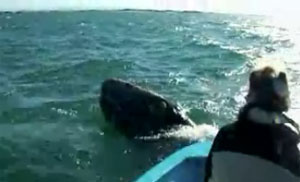Grey whales missing from traditional feeding grounds
Grey whales missing from traditional feeding grounds
mongabay.com
October 23, 2006
Researchers found few grey whales in their traditional feeding grounds in the North Pacific last summer according to a scientist at the University of Bath.
Dr. William Megill, a professor of mechanical engineering with special interest in biomimetics at the University of Bath, said that the absence of the 17,000 grey whales from traditional summer feeding grounds in the North Pacific could be cause for concern, despite the species’ recent removal from the endangered species list.
“Presumably they found other feeding areas, but they will have had to look hard. This suggests they may be quite lean this winter, particularly as this is now the second summer they’ve had to deal with this problem,” said Megill. “We know that the Bering Sea has taken a beating over the last ten years, and that productivity has plummeted there, forcing the whales into new habitat. A new blow to the productivity in these marginal habitats could hurt badly.”
 Earthwatch volunteers will help Dr. William Megill conduct research on grey whales in Baja California, Mexico this winter. Courtesy of the Earthwatch Institute 2006. Tyler Robinson and Jamie Lee Fiel.
|
Grey whales migrate some 6000-miles every year from their summer feeding grounds in the plankton-rich waters of the North Pacific to the warm wintering lagoons off Baja California, where they breed and give birth to their calves. While whales have rarely been observed to feed in these lagoons, Megill will be closely observing the feeding behaviors of these cetaceans this winter. The Earthwatch Institute, a global volunteer organization that supports scientific field research by offering members of the public unique opportunities to work alongside leading field scientists and researchers, is part of the effort. Earthwatch is recruiting volunteers to help support Megill’s research effort in Laguna San Ignacio, Mexico.
“We’re expecting to see the animals feeding even more in Mexican waters this year,” said Megill. “We’ll be heading out into the Pacific to see what the whales are doing offshore.”
More information
RELATED
Global warming could doom the walrus
A new study warns that walrus calves are being stranded by melting sea ice in the Arctic Ocean. Researchers aboard the U.S. Coast Guard icebreaker Healy during a cruise in the Canada Basin in the summer of 2004 found lone walrus calves swimming far from shore–something never before documented. The sightings suggest that increased polar warming may be forcing mothers to abandon their pups as they follow the rapidly retreating ice northwards. If these observations portray a larger trend, a warmer Arctic may lead to decreases in the walrus population say the scientists whose research was published in the April issue of Aquatic Mammals.
Polar bear may be listed as endangered species
The U.S. Fish and Wildlife Service today announced that it is considering a petition to list the polar bear (Ursus maritimus) as threatened under the Endangered Species Act. Scientists believe polar bear populations are increasingly in danger due to the effects of climate change, specifically receding ice and warming temperatures.